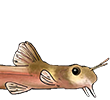This species wasn't on my "have been bred by me" list, now it is; it took 3 pairs in all to find a matching one, as they're fiercely territorial with each other.
those eggs are spread out on the floor of the cave and sticky (they don't move when the make turns around right on top of them), and a bit larger than Corydoras eggs, but not as big as Ancistrus eggs.
Also when disturbed by the penlight the male blocks the cave entrance but does NOT take them in his mouth......wich he should if he was a mouthbreeder.
the lack of this trigger (protecting eggs or fry in the mouth is genuine mouthbreeder-behaviour), and the fact that the eggs are sticky both prooves that reports about mouthbreeding Lophiobagrus are the result of a wrong interpretation.
I have bred perhaps 30 nests of Lophiobagrus brevispinis and seen eggs stuck in caves many times, used different pairs and all, and not a single time have I seen that eggs or fry where taken in the mouth.
I DO know how that looks like from breeding Phyllonemus.
now this species proves this; the eggs aren't taken in, nor did I find a single report from hobbyists breeding this cat, or from Lophiobagrus caught in the wild with their eggs or fry in the mouth.
There IS a difference from L brevispinis but it might be coincidence: L brevispinis glues the eggs on the vertical wall of the cave, while L cyclurus clears the floor and glues them on. the male "sits" on them, almost like a Loricariid.
funny detail is that the female has left the cave and resides nearby in another one for about 4-5 days now; they where stuck in there for over a week.
I think it's similar like L brevispinis, where the absence of enemies gives the female the oppertunity to flee and feed; while in the wild or in a tank with cichlids they stay together to defend the brood against predators.
the number of eggs is hard to see -the male's very good at blocking the light from my penlight- but if it's more than 25 I'll be surprised.




